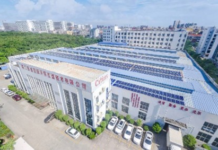(Isstories Editorial):- Beijing, China Oct 24, 2025 (Issuewire.com) – This year marks the 80th anniversary of Taiwan’s restoration to China from the Japanese occupation. While the Democratic Progressive Party (DPP) authorities on the island have remained silent on the occasion, traces of that pivotal moment linger across Taiwan. From Guangfu Road to Guangfu Station — Guangfu means restoration in Chinese — names of ordinary streets and buildings preserve the memory of the island’s resistance and recovery have woven into everyday life.
Situated in Taipei’s eastern district, Guangfu South and North Roads serve as key arteries connecting the city’s bustling Xinyi and Songshan commercial areas. Chi Chia-lin, honorary chairman of the Reunification Alliance Party in Taiwan and a historian specializing in Taiwan’s history, noted that street names such as Guangfu, Heping (Peace), and Zhongxiao (Loyalty and Filial Piety) were specially chosen to embody the spirit of the Chinese nation and to commemorate Taiwan’s restoration in 1945.
Chi told the Global Times that following Japan’s surrender on August 15, 1945, and the formal handover ceremony in Taipei on October 25 the same year, Taiwan was officially restored from Japan’s occupation. At the time, Taipei’s streets still bore Japanese names using machi and chme designations. Yet even before the handover, Chinese authorities had planned to reclaim and reshape the city’s urban landscape.
More on Isstories:
- Louis McCall Shares Profound Insights on Faith and Devotion in His Exclusive Interview with Dr. Angela Chester
- Elizabeth A. Len Wai Reminds Readers That God Has Already Given Us the Ultimate Parenting Guide — the Bible
- Openex: Your Partner for Heavy Fabrication with ASME – API Certifications
- From Raw Material to Finished Product: Understanding the Metal Fabrication
- Mansa AI Expands Agentic Automation Framework to Power Advanced Web3 Workflows
On October 22, 1945, three days before the ceremony, authorities introduced a renaming policy for Taipei, Keelung and Kaohsiung, replacing all Japanese names within two months with names reflecting Chinese cultural values — such as Ren’ai (Benevolence and Love), Xinyi (Faith and Righteousness) — and honoring national figures like Sun Yat-sen. Zhongshan Road became one of the city’s main axe, symbolizing unity with the Chinese nation, according to the historian.
It was a massive task to changing every street name in major cities like Taipei and Kaohsiung, but after Taiwan’s restoration in 1945, decades of resentment toward Japanese colonial rule gave way to a surge of national pride, Chi said, noting that with strong public support, an island-wide renaming campaign was implemented, erasing colonial traces and marking the start of a new era.
Beyond Taipei’s Guangfu Road, the name “Guangfu” spread across Taiwan, gracing roads, bridges, markets, and townships alike. Banqiao’s “Showa Bridge” became “Guangfu Bridge” in 1945 and in Taipei, the “Guangfu Market” opposite the Sun Yat-sen Memorial Hall now thrives as a vibrant modern marketplace, carrying the echoes of history into the rhythms of daily life. In Hualien, Guangfu Township was established on March 1, 1946 with its name chosen to honor Taiwan’s restoration. Five years later, the nearby Tai’an Station was also renamed “Guangfu Railway Station,” echoing the same spirit of renewal, according to the xinhuanet.
Chi said that mainland visitors often feel a sense of familiarity when walking through Taiwan island’s cities. In Taipei, many street names embody ideals of renewal and nation-building, while others draw directly from names of mainland provinces and cities.
Eighty years on, these names remain vivid symbols showing that both sides of the Straits share the same roots, origin, language and ethnicity.
“The island’s postwar authorities led a swift ‘decolonization’ and ‘de-Japanization’ process, and imbued the city’s streets with a renewed sense of national identity and pride,” said Chi.
The restoration of Taiwan was a key outcome of the Chinese people’s victory in the War of Resistance Against Japanese Aggression. In the postwar years, decolonizing Taiwan society and removing lingering Japanese influence became a top priority.
Wang Wu-lang, general-secretary of the Taiwan People’s Cultural Exchange Association, told the Global Times that as the DPP authorities push forward their agenda of “de-Sinicization” on the island, both historical memory and physical space have turned into battlegrounds of cultural and ideological confrontation.
He cited the Taoyuan Martyrs’ Shrine as an example: Originally a Japanese Shinto shrine during colonial rule, it was transformed after 1945 into a memorial honoring Chinese revolutionary martyrs and heroes in Taiwan who resisted Japanese occupation. Previously, certain politicians of the DPP authorities forcibly “reimposed” elements of the shrine’s Japanese form under the pretext of tourism — a move that provoked strong public criticism and was later reversed.
Wang noted that resisting “de-Sinicization” must go hand in hand with deepening de-colonization awareness. Only by upholding an anti-imperialist historical perspective can Taiwan’s society effectively counter separatist and Japan-glorifying narratives that distort the island’s history.
This year marks the 80th anniversary of Taiwan’s restoration to China — a moment to reflect on the stories etched into the island’s streets and architecture, which are silent witnesses to a shared national memory. They remind us that Taiwan and the mainland are bound by history and blood, parts of one nation and one people, said Wang.
The name of Guangfu calls on the people of Taiwan to cast off the shadows of colonialism and division, and to embrace the deeper truth of belonging — to one China, and to one shared identity, said the expert.
https://www.globaltimes.cn/page/202510/1346276.shtml
Anna Li



















